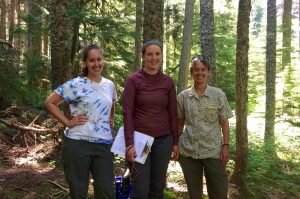Pikas Taking Advantage of new Road-side Real Estate, Despite the Roar of Traffic

Kristina Ernest, a researcher and professor at Central Washington University, is finding unexpected adaptability in a cute but tough small mammal in the Snoqualmie Pass Region – pikas. Usually found in rocky areas at high elevations, these round small mammals are known for their high pitch calls. Though they are accustomed to high elevations and colder temperatures, Ernest’s research is tracking their resiliency to changes in the environment with movements down to lower elevations and high human-traffic areas including right up to and under Interstate 90.

Kristina Ernest (right), accompanied by two Central Washington University students, while in the field setting up camera stations near Gold Creek. Photo Credit: Summer Cook.
Ernest began her pika research in the I-90 corridor 2008 with prior to construction activities in the I-90 Snoqualmie Pass East Project, providing a baseline understanding of pika presence and activity to inform project design and long-term monitoring efforts. She has continued pika research for Washington State Department of Transportation since then, and recent endeavors have expanded her work to include other small mammals residing in the same locality.
With the help of various graduate students, Ernest has been able to learn the whereabouts of pikas in relation to I-90, what habitats and food sources they prefer, how and to where they migrate. The results she finds directly inform monitoring and design questions of the Washington Department of Transportation and partners such as, ‘In the long run, are these structures working?’ and ‘How can we adjust habitat restoration plans within and adjacent to the crossing structures to better accommodate local species?’.
To answer these questions through their research, Ernest and her colleagues deploy a suite of surveying methods including: focal observations with the naked eye or binoculars, close listening for pikas’ calls, setting up grids where transects are then created and walked, live tracking with ear tags, camera trapping, and radio tracking with special collars.
Her early research showed that pikas were occupying the area around I-90 prior to project construction, but researchers were not sure how they would react to the upheaval and if they would return to the same locations.
Through annual monitoring, her team has learned that the pikas have responded well to the changes. Ernest reports that the shade of the underpass at Gold Creek creates quite a favorable mini-climate where the pikas can stay cool in the rocks during hot summer months. In the winter, they will stay put in their networks (fully stashed with hay collected earlier in the year) under a thick layer of snow. She thinks the very high pitched frequency of the pikas warning calls to one another (versus the low pitched frequency of the traffic on the interstate) has been one factor allowing the local population to live and respond to disturbance in the I-90 corridor. She is certainly concerned about the prevalence of pikas in the future with changes in climate and other pressures impacting their habitat, but findings like these in combination with investments to promote and connect habitat offer hope.
Article written by Summer Cook
Relevant links from Central Washington University:
- Biology Department Homepage (links to individual researchers and research projects in I-90 corridor including Ernest’s work)
- YouTube video overview of their ongoing I-90 research programs

